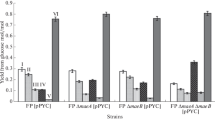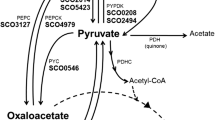Abstract
The malic enzyme gene ofAscaris suum was cloned into the vector pTRC99a in two forms encoding alternative arnino-termini. The resulting plasmids, pMEAl and pMEA2, were introduced intoEscherichia coli NZN111, a strain that is unable to grow fermentatively because of inactivation of the genes encoding pyruvate dissimilation. Induction of pMEAl, which encodes the native animoterminus, gave better overexpression of malic enzyme, approx 12-fold compared to uninduced cells. Under the appropriate culture conditions, expression of malic enzyme allowed the fermentative dissimilation of glucose by NZN111. The major fermentation product formed in induced cultures was succinic acid.
Similar content being viewed by others
References
Jain, M. K., Datta, R., and Zeikus, J. G. (1989), inBio-process Engineering: The First Generation Ghose, T. K., ed., Norwood, Chichester, UK, pp. 366–389.
Clark, D. P. (1989),FEMS Microb. Rev. 63, 223–234.
Blackwood, A. C., Neish, A. C., and Ledingham, G. A. (1956),J. Bacteriol. 72, 497–499.
Millard, C. S., Chao, Y.-P., Liao, J. C., and Donnelly, M. I. (1996),Appl. Environ. Microbiol. 62, 1808–1810.
Thauer, R. K., Jungermann, K., and Decker, K. (1977),Bacteriol. Rev. 41, 100–180.
Murai, T., Tokushige, M., Nagai, J., and Katsuki, H. (1971),Biochem. Biophys. Res. Comm. 43, 875–881.
Murai, T., Tokushige, M., Nagai, J., and Katsuki, H. (1972),J. Biochem. 71, 1015–1028.
Landsperger, W. J. and Harris, B. G. (1976),J. Biol. Chem. 251, 3599–3602.
Takeo, K., Murai, T., Nagai, J., and Katsuki, H. (1967),Biochem. Biophys. Res. Comm. 29, 717.
Sanwal, B. D. (1970),J. Biol. Chem. 245, 1212–1216.
Mallick, S., Harris, B. G., and Cook, P. F. (1991),J. Biol. Chem. 266, 2732–2738.
Mat-Jan, F., Kiswar, A. Y., and Clark, D. P. (1989),J. Bacteriol. 171, 342–348.
Boernke, W. E., Millard, C. S., Stevens, P. W., Kakar, S. N., Stevens, F. J., and Donnelly, M. I. (1995),Arch. Biochem. Biophys. 322, 43–52.
Kulkarni, G., Cook, P. F., and Harris, B. G. (1993),Arch. Biochem. Biophys. 300, 231–237.
Mahajan, S. K., Chu, C. C., Willis, D. K., Templin, A., and Clark, A. J. (1990),Genetics 125, 261–273.
Sambrook, J., Fritsch, E. F., and Maniatis, T. (1989),Molecular Cloning: A Laboratory Manual, 2nd ed., 2nd ed., Cold Spring Harbor Press, Cold Spring Harbor, NY.
Balch, W. and Wolfe, R. S. (1976),Appl. Environ. Microbiol. 32, 781–791.
Author information
Authors and Affiliations
Rights and permissions
About this article
Cite this article
Stols, L., Kulkarni, G., Harris, B.G. et al. Expression ofAscaris suum malic enzyme in a mutantEscherichia coli allows production of succinic acid from glucose. Appl Biochem Biotechnol 63, 153–158 (1997). https://doi.org/10.1007/BF02920421
Issue Date:
DOI: https://doi.org/10.1007/BF02920421




